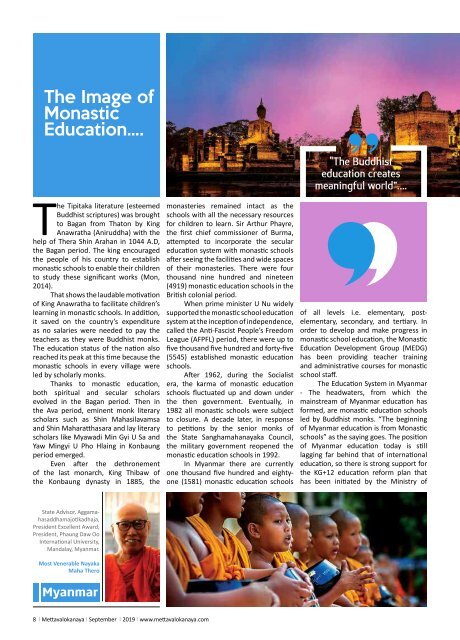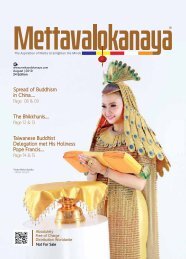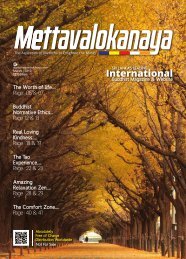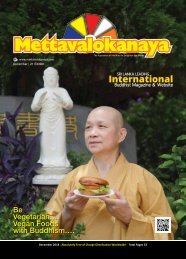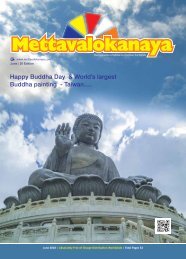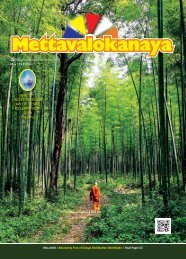Mettavalokanaya_International_Buddhist_Magazine_September_2019
This is the Sri Lankan's Most Popular & Leading Monthly International Buddhist Magazine, “Mettavalokanaya” on September 2019 Edition - 25. Now you can download & read our “Mettavalokanaya” all Magazines via online. “Mettavalokanaya” Buddhist Magazine has been successfully distributed to 40 countries including all districts across Sri Lanka and distribute to all Overseas Chief Sangha Nayaka Theros, Worldwide Buddhist Associations, High Commissions & Embassies situated in Sri Lanka & overseas Sri Lankan High Commissions & Embassies.
This is the Sri Lankan's Most Popular & Leading Monthly International Buddhist Magazine, “Mettavalokanaya” on September 2019 Edition - 25.
Now you can download & read our “Mettavalokanaya” all Magazines via online.
“Mettavalokanaya” Buddhist Magazine has been successfully distributed to 40 countries including all districts across Sri Lanka and distribute to all Overseas Chief Sangha Nayaka Theros, Worldwide Buddhist Associations, High Commissions & Embassies situated in Sri Lanka & overseas Sri Lankan High Commissions & Embassies.
You also want an ePaper? Increase the reach of your titles
YUMPU automatically turns print PDFs into web optimized ePapers that Google loves.
The Image of<br />
Monastic<br />
Education….<br />
The Tipitaka literature (esteemed<br />
<strong>Buddhist</strong> scriptures) was brought<br />
to Bagan from Thaton by King<br />
Anawratha (Aniruddha) with the<br />
help of Thera Shin Arahan in 1044 A.D,<br />
the Bagan period. The king encouraged<br />
the people of his country to establish<br />
monastic schools to enable their children<br />
to study these significant works (Mon,<br />
2014).<br />
That shows the laudable motivation<br />
of King Anawratha to facilitate children’s<br />
learning in monastic schools. In addition,<br />
it saved on the country’s expenditure<br />
as no salaries were needed to pay the<br />
teachers as they were <strong>Buddhist</strong> monks.<br />
The education status of the nation also<br />
reached its peak at this time because the<br />
monastic schools in every village were<br />
led by scholarly monks.<br />
Thanks to monastic education,<br />
both spiritual and secular scholars<br />
evolved in the Bagan period. Then in<br />
the Ava period, eminent monk literary<br />
scholars such as Shin Mahasilavamsa<br />
and Shin Maharatthasara and lay literary<br />
scholars like Myawadi Min Gyi U Sa and<br />
Yaw Mingyi U Pho Hlaing in Konbaung<br />
period emerged.<br />
Even after the dethronement<br />
of the last monarch, King Thibaw of<br />
the Konbaung dynasty in 1885, the<br />
State Advisor, Aggamahasaddhamajotikadhaja,<br />
President Excellent Award,<br />
President, Phaung Daw Oo<br />
<strong>International</strong> University,<br />
Mandalay, Myanmar.<br />
Most Venerable Nayaka<br />
Maha Thero<br />
Myanmar<br />
monasteries remained intact as the<br />
schools with all the necessary resources<br />
for children to learn. Sir Arthur Phayre,<br />
the first chief commissioner of Burma,<br />
attempted to incorporate the secular<br />
education system with monastic schools<br />
after seeing the facilities and wide spaces<br />
of their monasteries. There were four<br />
thousand nine hundred and nineteen<br />
(4919) monastic education schools in the<br />
British colonial period.<br />
When prime minister U Nu widely<br />
supported the monastic school education<br />
system at the inception of independence,<br />
called the Anti-Fascist People’s Freedom<br />
League (AFPFL) period, there were up to<br />
five thousand five hundred and forty-five<br />
(5545) established monastic education<br />
schools.<br />
After 1962, during the Socialist<br />
era, the karma of monastic education<br />
schools fluctuated up and down under<br />
the then government. Eventually, in<br />
1982 all monastic schools were subject<br />
to closure. A decade later, in response<br />
to petitions by the senior monks of<br />
the State Sanghamahanayaka Council,<br />
the military government reopened the<br />
monastic education schools in 1992.<br />
In Myanmar there are currently<br />
one thousand five hundred and eightyone<br />
(1581) monastic education schools<br />
"The <strong>Buddhist</strong><br />
education creates<br />
meaningful world”….<br />
of all levels i.e. elementary, postelementary,<br />
secondary, and tertiary. In<br />
order to develop and make progress in<br />
monastic school education, the Monastic<br />
Education Development Group (MEDG)<br />
has been providing teacher training<br />
and administrative courses for monastic<br />
school staff.<br />
The Education System in Myanmar<br />
- The headwaters, from which the<br />
mainstream of Myanmar education has<br />
formed, are monastic education schools<br />
led by <strong>Buddhist</strong> monks. “The beginning<br />
of Myanmar education is from Monastic<br />
schools” as the saying goes. The position<br />
of Myanmar education today is still<br />
lagging far behind that of international<br />
education, so there is strong support for<br />
the KG+12 education reform plan that<br />
has been initiated by the Ministry of<br />
Education. The scourge of the current<br />
education system in Myanmar is “rote<br />
learning”. The following reforms to<br />
change this system are desperately<br />
needed:<br />
Reforming the Entire Education<br />
System - As mentioned above, Myanmar<br />
education is seriously deficient<br />
compared to international provision. In<br />
fact, the present education system of<br />
Myanmar has been inherited from the<br />
British, although that system no longer<br />
exists in Britain as it has long since been<br />
reformed. The timely initiation of the<br />
Ministry of Education to embrace the<br />
formation of a KG+12 system is fully<br />
appreciated. In the <strong>2019</strong>/2020 academic<br />
year, it is heartening to know that Grades<br />
1, 2, 3 and 6 have already been reformed.<br />
However, when it comes to<br />
the higher education sector there<br />
are still many aspects to reform. In<br />
national education law, the autonomy<br />
of universities has been enacted by<br />
the Union Parliament. Accordingly,<br />
universities registered in Myanmar have<br />
the right to autonomy, but criticism exists<br />
concerning the limitations surrounding<br />
increased efficiency and competitiveness<br />
(University World News, 2018).<br />
Reforming Teaching Methodology<br />
- At present, the only teaching<br />
methodology applied in Myanmar<br />
education is “rote learning” which pays<br />
most attention to memorizing facts. In<br />
modern teaching systems the students<br />
are taught how to analyze the facts<br />
and to create new entities based on<br />
those facts. When Myanmar students<br />
see a reading passage, they think it has<br />
to be memorized, while students of<br />
other nationalities know it needs to be<br />
analyzed. Myanmar students will receive<br />
high marks if they give specifically<br />
memorized answers in the examination<br />
rather than attempting to answer the<br />
questions themselves.<br />
Visits to many countries to observe<br />
their education systems have revealed<br />
very different approaches. For example<br />
a trip to the United World College<br />
(UWC) in Singapore, witnessed Grade 8<br />
students sitting an examination looking<br />
at a projector screen displaying the<br />
comment “Facts are important, but if<br />
you do not analyze, they are useless”.<br />
The students were using the facts on<br />
the screen and applying them to present<br />
their own views. Given that this situation<br />
is happening worldwide, Myanmar<br />
must urgently reform the teaching<br />
methodologies used by teachers in all<br />
schools.<br />
Reforming Assessment - The<br />
present assessment practice in Myanmar,<br />
with matriculation at the end of the<br />
education process, is the legacy of the<br />
British. Britain has reformed its national<br />
education assessment systems many<br />
times since the end of the Second World<br />
War. It is astonishing that Myanmar has<br />
been using the same education system<br />
until now. Daily assessment of the<br />
activities for each and every student is<br />
routinely used in classrooms globally.<br />
Students respond well to this system as<br />
they feel their activities are recognized<br />
and appreciated. These regular<br />
assessment records show the real<br />
capabilities of the students and whether<br />
to upgrade them to the next level yearly.<br />
Examinations only imposed at the end of<br />
an academic year often fail to determine<br />
the real quality of a student. ‘There<br />
are no national tests for pupils in basic<br />
education in Finland’ (FNAFE, 2018). It<br />
has often been purported that ‘Finnish<br />
has one of the best education systems in<br />
the world’ (Jackson, 2016).<br />
In Myanmar, holding summative<br />
examinations for Grade 4 (at township<br />
level) and Grade 8 (at district level) is<br />
really like giving the wrong treatment to a<br />
patient. Deciding the abilities of students<br />
just by holding external summative<br />
examinations is committing a huge<br />
mistake on the part of those innocent<br />
children. Only the teachers who closely<br />
look after the students will accurately<br />
know their real capabilities and levels<br />
of attainment. Worst of all is the terrible<br />
waste of human resources that results<br />
from failing 70 percent of Grade 10<br />
(university entrance level) students.<br />
In Australia, students of Year 12 can<br />
apply to their preferred universities with<br />
a score that takes 50 percent from their<br />
school assessment record and the other<br />
half from external examinations. As<br />
the universities are granted autonomy,<br />
they also have the right to admit their<br />
preferred students. A “No pass, no fail,<br />
all completion” system is exercised at<br />
Year 12 in Australia.<br />
Therefore, given the holistic nature<br />
of international education, we suggest<br />
that the students who pass Grade 10,<br />
as per the status quo, should enter<br />
university directly. Those students who<br />
complete the courses under standard<br />
assessment should be awarded a<br />
completion certificate, then they should<br />
have the chance to apply to their<br />
preferred university and sit an entrance<br />
exam for that university. Alternatively,<br />
there should be another system for<br />
students who have gained a completion<br />
certificate, in so far as they could attend<br />
a particular diploma program and when<br />
they meet the entry requirements,<br />
they could continue their education at<br />
university level. Such a process would<br />
effectively develop the human resources<br />
of Myanmar, whilst simultaneously<br />
the entire education system would<br />
be significantly improved; altogether<br />
creating a better educated society.<br />
8 l <strong>Mettavalokanaya</strong> l <strong>September</strong> l <strong>2019</strong> l www.mettavalokanaya.com www.mettavalokanaya.com l <strong>2019</strong> l <strong>September</strong> l <strong>Mettavalokanaya</strong> l 9


